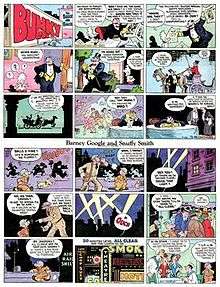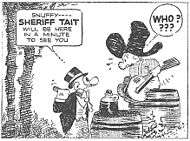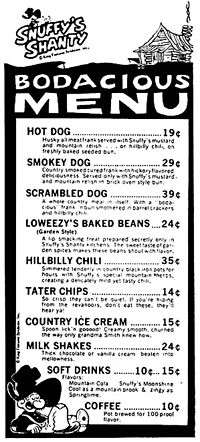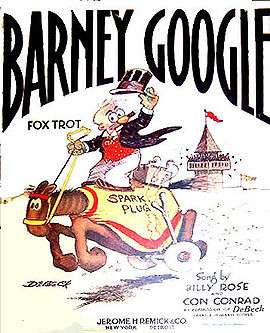Barney Google and Snuffy Smith
| Barney Google and Snuffy Smith | |
|---|---|
 Bunky and Barney Google and Snuffy Smith (July 26, 1942) | |
| Author(s) | Billy DeBeck |
| Current status / schedule | Running |
| Launch date | June 17, 1919 |
| Syndicate(s) | King Features Syndicate |
| Publisher(s) | Cupples & Leon, Hyperion Press, Kitchen Sink Press, IDW Publishing |
| Genre(s) | Humor |
Barney Google and Snuffy Smith, originally Take Barney Google, F'rinstance, is an American comic strip created by cartoonist Billy DeBeck. Since its debut on June 17, 1919, the strip has gained a huge international readership, appearing in 900 newspapers in 21 countries. The initial appeal of the strip led to its adaptation to film, animation, popular song and television. It added several terms and phrases to the English language and inspired the 1923 hit tune "Barney Google (with the Goo-Goo-Googly Eyes)" with lyrics by Billy Rose, as well as the 1923 record, "Come On, Spark Plug!"
Barney Google himself, once the star of the strip and a very popular character in his own right, has been almost entirely phased out of the feature. An increasingly peripheral player in his own strip beginning in the late 1930s, Google was officially "written out" in 1954, although he would occasionally return for cameo appearances. These cameos were often years apart—from a period between 1997 and 2012, Barney Google wasn't seen in the strip at all. Google was reintroduced to the strip in 2012, and has been seen very occasionally since, making several week-long appearances.
Snuffy Smith, who was initially introduced as a supporting player in 1934, has now been the comic strip's central character for over 60 years. Nevertheless, the feature is still titled Barney Google and Snuffy Smith.
Characters and story
Barney Google

Like Mutt and Jeff, Barney Google started out on the sports page. First appearing as a daily strip in the sports sections of the Chicago Herald and Examiner in 1919, it was originally titled Take Barney Google, F'rinstance. The title character, a little fellow (although he would shrink in stature even more after the first year) with big "banjo" eyes, was an avid sportsman and ne'er-do-well involved in poker, horse racing and prize fights.
The "goggle-eyed, moustached, gloved and top-hatted, bulbous-nosed, cigar-chomping shrimp" (according to comics historian Bill Blackbeard) was relentlessly henpecked by "a wife three times his size" (as the song lyric goes). The formidable Mrs. Lizzie Google, a.k.a. "the sweet woman", sued Barney for divorce and thereafter virtually disappeared from the strip. By October 1919, the strip was distributed by King Features Syndicate and was published in newspapers across the country.
Spark Plug
Beginning on July 17, 1922, the strip would take a momentous turn in popularity with the seemingly innocuous introduction of an endearing race horse named "Spark Plug". Barney's beloved "brown-eyed baby" was a bow-legged nag who seldom raced, and he was typically seen almost totally covered by his trademark patched blanket with his name scrawled on the side. Peanuts creator Charles M. Schulz was known to his friends as Sparky, a lifelong nickname given to him by his uncle as a diminutive of Barney Google's Spark Plug. Comics historian Don Markstein noted that,
Sparky's first race became one of comics' first national media events, eagerly anticipated by millions of newspaper readers. So great was the public's enthusiasm that DeBeck, who had been planning to retire the plug after that one storyline, made him a permanent part of the cast. Spark Plug was such a star during the 1920s that children who enjoyed the comics were liable to get "Sparky" for a nickname—for example, Charles M. "Sparky" Schulz, who grew up to create Peanuts.[1]
In deference to his enormous popularity during this period, the strip was retitled Barney Google and Spark Plug.[2] DeBeck's strip hit its peak of popularity with Spark Plug at about the same time the song "Barney Google (Foxtrot)" by Billy Rose and Con Conrad was sweeping the country. It would become one of the best known, most iconic novelty records of the 1920s, and has been recorded by such famous artists as Eddie Cantor and The Happiness Boys, The Andrews Sisters, and Spike Jones:
- Who's the most important man this country ever knew?
- Who's the man our presidents tell all their troubles to?
- No, it isn't Mr. Bryan and it isn't Mr. Hughes;
- I'm mighty proud that I'm allowed a chance to introduce:
- Barney Google—with the goo, goo, googly eyes,
- Barney Google—bet his horse would win the prize;
- When the horses ran that day,
- Spark Plug ran the other way!
- Barney Google—with the goo-goo-googly eyes!
- Who's the greatest lover that this country ever knew?
- Who's the man that Valentino takes his hat off to?
- No, it isn't Douglas Fairbanks that the ladies rave about;
- When he arrives, who makes the wives chase all their husbands out?
- Barney Google—with the goo-goo-googly eyes,
- Barney Google—had a wife three times his size;
- She sued Barney for divorce,
- Now he’s sleeping with his horse!
- Barney Google—with the goo-goo-googly eyes!
Other popular characters and concepts introduced in the strip about this time include "Sunshine", Barney's black jockey, a troublesome ostrich named "Rudy", "Sully", a monocled champion wrestler, and the mysterious hooded fraternity "The Order of the Brotherhood of Billy Goats", a parody of mystic secret societies. (There was also a "Sisterhood of Nanny Goats" for the ladies.) Their password was "O-K-M-N-X" which, deciphered, stood for a standard breakfast order ("Okay, ham and eggs"). Barney was elected "Exalted Angora" in 1928. (Source: Barney Google and Snuffy Smith: 75 Years of an American Legend. Kitchen Sink Press, pgs. 88–91. 1994.)

Snuffy Smith
In 1934, an even greater change took place when Barney and his horse visited the North Carolina mountains and met a volatile, equally diminutive moonshiner named Snuffy Smith. Hillbilly humor was extremely popular at the time (as Al Capp was proving with Li'l Abner ). The strip increasingly focused on the southern Appalachian hamlet of "Hootin’ Holler", with Snuffy as the main character. The mountaineer locals are extremely suspicious of any outsiders, referred to as "flatlanders" or even worse, "revenooers" (Federal Revenue agents).
Snuffy was so popular that his name was added to the strip's title in the late 1930s. Eventually, Barney Google himself left Hootin' Holler in 1954 to return to the city, and was essentially written out of the strip except as a very occasional visitor. Google has appeared extremely rarely in the feature since the mid-1950s, but returned to Hootin' Holler for a visit in a series of strips beginning on February 19, 2012,[3] with occasional visits since. Prior to 2012, Google had not appeared in the strip since January 5, 1997, a span of over 15 years.
Snuffy Smith (whose last name is pronounced "Smif" by virtually all the characters in Hootin' Holler) is an ornery little cuss, sawed-off and shiftless. He lives in a shack, mangles the English language and has a propensity to shoot at those who displease him. He makes "corn-likker" moonshine in a homemade still and is in constant trouble with the sheriff. He wears a broad-brimmed felt hat almost as tall as he is, has a scraggly mustache and a pair of tattered, poorly patched overalls. He constantly cheats at poker and checkers. He also has some proclivity toward stealing chickens, which led to a brief but effective use of his character in a marketing campaign by the Tyson Foods corporation in the early 1980s. In 1937 he held the post of "Royal Doodle Bug" in the "Varmints" lodge; during this period, the strip heavily employed the catchphrase, "What did the Doodle-Bug say?", an apparent homage to "What did the Woggle-Bug say?" in L. Frank Baum and Walt McDougall's Queer Visitors from the Marvelous Land of Oz strip of 1904–1905.
Almost all of the characters in the strip (except the occasional visiting "flatlander") are exaggerated hillbillies in the classic burlesque tradition:[4] sharp-tongued gossipy women such as Snuffy's wife "Loweezy"; his baby "Tater"; his nephew "Jughaid"; his neighbors Elviney and "Lukey"[5] (Lucas Ebenezer Hinks);[6][7] the sanctimonious (but nonetheless ungrammatical) Parson; Silas, the owner of the General Store; the ostentatiously-badged Sheriff Tait, and others.[5] Vehicles are rundown jalopies of a seeming 1920s vintage, even in the 1970s and beyond. The characters are drawn so that they appear to be talking out of the sides of their mouths.
Topper strips
Bughouse Fables
In 1921, DeBeck began a gag panel called Bughouse Fables, featuring his observations of ordinary people doing foolish things, which he signed "Barney Google". He later added Bughouse Fables as an accompanying topper strip, to run with Barney Google on Sundays.
Bunky
On May 16, 1926, DeBeck began another topper strip, originally called Parlor, Bedroom and Sink—but better known as Bunky. Parlor Bedroom and Sink—which evolved into Parlor Bedroom and Sink Starring Bunky, and eventually simply Bunky—is an over-the-top parody of stage melodramas and movie and radio serials that were popular at the time. The title character "Bunky" (short for Bunker Hill, Jr.) was a hapless waif whose penniless parents, Bunker Hill, Sr. and Bibsy, had given birth to the strangely erudite newborn with the enormous nose on November 13, 1927. The irresponsible Bunker Sr. eventually disappeared from the strip. From then on, pint-sized Bunky (still dressed in the baby bonnet and gown in which he was first seen) was the star, protector and benefactor of the family. His vocabulary rivaled that of any educated adult.
Arch-nemesis Fagin, introduced in 1928, was as vile and despicable a villain as any Charles Dickens antagonist. He “would steal pennies from a blind man's cup and kick dogs that weren't even in his way. Robbing widows and orphans... was routine for him", according to comics historian Don Markstein, who said the strip popularized the phrase, "Youse is a viper!"[8]
Fantasy author and Conan the Barbarian creator Robert E. Howard, a big fan of Bunky, was fond of quoting from the strip, as noted by his friend, Tevis Clyde Smith.[9][10] After DeBeck's death in 1942, Bunky continued for a time under Joe Musial (The Katzenjammer Kids) and Fred Lasswell. The series ended in 1948.
Fred Lasswell and other artists
Billy DeBeck died of cancer in 1942 at the age of 52. DeBeck's lifelong assistant Fred Lasswell, a self-described "hayseed" himself, took over Barney Google and Snuffy Smith in 1942. In the 1950s, Lasswell phased out DeBeck's long storylines in favor of a standard gag-a-day format. Lasswell drew the strip until his death on March 3, 2001. Other assistants to DeBeck included Cliff Rogerson (later an editorial cartoonist for Newsday, beginning in 1946) and Paul Fung, Jr.
John R. Rose
In mid-1998, editorial cartoonist John R. Rose began as Lasswell's inking assistant, and he became the strip's cartoonist after Lasswell's death in 2001. Rose has stated that being the cartoonist for King Features' Barney Google and Snuffy Smith comic strip has been the greatest joy of his professional career. In addition to being the artist on this popular, long running strip, Rose is the editorial cartoonist for Byrd Newspapers of Virginia and creates Kids' Home Newspaper, a weekly syndicated puzzle feature for Creators Syndicate. He has authored several books, including The Bodacious Best of Snuffy Smith in 2013 and Balls Of Fire! More Snuffy Smith Comics in 2016. Rose is credited with bringing back the Barney Google character on a semi-regular basis after the character's long absence. Margaret Shulock is one of the strip's uncredited writers. Its other is cartoonist Mike Marland. In 2015 Rose was honored with the Lum and Abner Memorial Award in Mena, AR by the National Lum And Abner Society for his contributions to rural humor as the cartoonist for the Barney Google and Snuffy Smith comic strip.
Origin of "Google"
Following "The Goo-Goo Song" (1900), the word "Google" was introduced in 1913 in Vincent Cartwright Vickers' The Google Book, a children's book about the Google and other fanciful creatures who live in Googleland:
"The Google has a beautiful garden which is guarded night and day. All through the day he sleeps in a pool of water in the center of the garden; but when the night comes, he slowly crawls out of the pool and silently prowls around for food."[11]
Aware of the word's appeal, DeBeck launched his comic strip six years later, and the "goo-goo-googly" lyrics in the 1923 song "Barney Google" focused attention on the novelty of the word.
When mathematician and Columbia University professor Edward Kasner was challenged in the late 1930s to devise a name for a very large number, he asked his nine-year-old nephew, Milton Sirotta, to suggest a word. The youthful comic strip reader told Kasner to use "Google". Kasner agreed, and in 1940, he introduced the words "googol" and "googolplex" in his book, Mathematics and the Imagination. Milton Sirotta died in 1980.[12][13] This is the term that Larry Page and Sergey Brin had in mind when they named their company in 1998, but they intentionally misspelled "googol" as "google," bringing it back full circle to Vickers' form. In 2002, when Page set up a scanning device at Google to test how fast books could be scanned, the first book he scanned was Vickers' The Google Book.[14][15][16][17]
Legacy
DeBeck, who had a gift for coining colorful terms, is credited with introducing several Jazz Age slang words and phrases into the English language—including "sweet mama", "horsefeathers", “heebie-jeebies”, “hotsy-totsy” and “Who has seen the doodle bug?” Snuffy's catchphrases “great balls o’ fire” and “time's a-wastin'” remain popular to this day.
In DeBeck's memory, the National Cartoonists Society in 1946 introduced the Billy DeBeck Award. (Eight years later, the name was changed to the Reuben Award after Rube Goldberg.) In 1963, Lasswell won both the NCS Humor Comic Strip Award and Reuben Award. That same year, he won the Society's plaque for Best Humor Strip. In 1984, the Society gave him its Elzie Segar Award (named after the creator of Popeye) for outstanding contributions to his profession.
Snuffy Smith currently appears in 21 countries and 11 languages. In 1995, the strip was honored by the U.S. Postal Service; it was one of 20 included in the Comic Strip Classics series of commemorative USPS postage stamps.
Licensing
Snuffy Smith makes a brief appearance in Clifford D. Simak's Out of Their Minds.
Toys and merchandise

Spark Plug captured the nation's hearts and imagination during the 1920s, and became a merchandising bonanza for King Features and Billy DeBeck. "Spark Plug, I am happy to say, has caught on," wrote DeBeck in 1924. "All over the United States you find stuffed Spark Plugs and Spark Plug games and Spark Plug drums and Spark Plug balloons and Spark Plug tin pails. And there is a Spark Plug play on the road. The only thing that is lacking is a Spark Plug grand opera." (Source: Barney Google and Snuffy Smith: 75 Years of an American Legend, page 35).
In 1960, King Features made plans to have Snuffy Smith serving hot dogs and chili at Snuffy's Shantys across the country, the grandiose plan of a Columbus, Georgia franchiser who had hoped to have 700 Shantys operating by 1970.[18]
In July 2004, Dark Horse Comics issued a limited edition figure of Barney Google in a colorful collector tin as statue number 47 in their line of Classic Comic Character figures.
Sheet music
- Barney Google Foxtrot by Billy Rose and Con Conrad (1923) Jerome H. Remick & Co.
- Come On, Spark Plug! by Billy Rose and Con Conrad (1923) Waterson, Berlin & Snyder Co.
- Bug House Fables by Clarence Gaskill (1923) M. Witmark & Sons
- So I Took the $50,000 by Jack Meskill and Al Gumble (1923) Jerome H. Remick & Co.
- O-K-M-N-X We're Twenty Million Strong (aka: The Brotherhood of Billy Goats) by Phil Baker, J. Russel Robinson and Sid Silvers (1928) Jerome H. Remick & Co.
- Time's a-Wastin' (The Original Yard Bird Song) by Olsen and Johnson, Jay Levison and Ray Evans (1941) Broadcast Music, Inc.
Comic books
Barney Google and/or Snuffy Smith each had a spotty history in comic books, starting with the first issue of David McKay's Ace Comics (1937). They appeared in their own comics as well—three issues from Dell Comics in the 1940s, four from Toby Press in the 1950s, one from Gold Key Comics in the 1960s, and six from Charlton Comics in the 1970s. In December, 2015, Snuffy Smith returned to comic books. John Rose wrote and illustrated the comic book story "Hopalong Jughaid" for Charlton Spotlight #9.
Book collections and reprints
(All titles by Billy Debeck unless otherwise noted.)
- Barney Google and His Faithful Nag Spark Plug (1923) Cupples & Leon Co.
- Barney Google and Spark Plug #2 (1924) Cupples & Leon Co.
- Barney Google and Spark Plug #3 (1925) Cupples & Leon Co.
- Barney Google and Spark Plug #4 (1926) Cupples & Leon Co.
- Barney Google (1935) Big Little Book #1083 Saalfield
- Barney Google: 1919–1920 (1977) Hyperion Press ISBN 0-88355-631-6
- The Smithsonian Collection of Newspaper Comics (1977) Smithsonian Institution Press/Harry Abrams (Bill Blackbeard, ed.)
- Barney Google and Snuffy Smith: 75 Years of an American Legend (1994) Kitchen Sink Press (Brian Walker, ed.) ISBN 0-87816-283-6
- Barney Google: Gambling, Horse Races and High-Toned Women! (2010) Yoe! Books (imprint of IDW) ISBN 1-60010-670-6
- The Bodacious Best of Snuffy Smith" (2013) Lulu.com (John Rose) ISBN 978-1-300-28330-0
- Balls Of Fire! More Snuffy Smith Comics" (2016) Lulu.com (John Rose) ISBN 978-1-329-51608-3
Film and television
1920s

Beginning in 1928, Barney Hellum portrayed Barney Google in a series of silent live-action short films for F.B.O. Pictures, also featuring Philip Davis as Sunshine.
- Horsefeathers (1928)
- OKMNX (1928) (aka Barney Google's Welcome Home)
- T-Bone Handicap (1928)
- Money Balks (1928)
- The Beef-Steaks (1928)
- Runnin' Through the Rye (1929)
- Sunshine's Dark Moment (1929)
- Neigh, Neigh, Spark Plug (1929)
- A Horse on Barney (1929)
- Just a Stall (1929)
- The Pace That Thrills (1929)
- Slide, Sparky, Slide (1929)
1930s
There was an animated cartoon Barney Google series in the mid-1930s, produced by the Charles Mintz Screen Gems Studio. Mintz made only four Barney Google cartoons, all released theatrically through Columbia Pictures.
- Tetched in the Head (1935)
- Patch Mah Britches (1935)
- Spark Plug (1936)
- Major Google (1936)
1940s
Spree for All (1946), an animated Noveltoon produced by Famous Studios, distributed through Paramount Pictures. It was produced in color, but currently only exists in a French black and white print.[19]
Two low-budget, live-action B features based on the strip were produced at Monogram Pictures in 1942: Private Snuffy Smith (aka Snuffy Smith, Yardbird) and Hillbilly Blitzkrieg. Diminutive actor Bud Duncan portrayed Snuffy in both films, with Cliff Nazarro appearing as Barney in Hillbilly Blitzkrieg.[1] (Both films also feature former Keystone Cop Edgar Kennedy and future Mouseketeer Jimmie Dodd in supporting roles.)
1960s
In 1963, King Features Syndicate released 50 six-minute Snuffy Smith cartoons for television, produced by Paramount Cartoon Studios in New York. The opening credits included a catchy theme song that was specifically composed for the cartoon:
- Uh-uh-oh! Great balls o' fire, I'm bodacious!
- Uh-uh-oh! Great balls o' fire, I'm a fright!
- Uh-uh-oh! Great balls o' fire, goodness gracious!
- I'm chop-chop-chop-chop-choppin' with all o' my might—YEA!
Other King Features properties, such as Beetle Bailey and Krazy Kat, also appeared as rotating segments under the collective title: King Features Trilogy. The series was widely shown in TV syndication (although Snuffy's Song, The Hat, The Method and Maw, and Take Me to Your Gen'rul were released theatrically), with prolific voice actor Paul Frees providing the voices of both Snuffy and Barney. Ge Ge Pearson also doubled as Loweezy and Jughaid. A number of episodes feature animation by famed animator Jim Tyer.[20] (All 50 episodes are available on the fourth DVD of the Advantage Cartoon Mega Pack.)
- Snuffy's Song (1962)
- The Hat
- The Method and Maw
- Take Me to Your Gen'rul
- Snuffy's Turf Luck (1963)
- Pie in the Sky
- The Berkeley Squares
- The Shipwreckers
- The Master
- Barney Deals the Cars
- Snuffy Runs the Gamut
- The Tourist Trap
- Rip Van Snuffy
- Snuffy Goes to College
- Snuffy's Brush with Fame
- Give a Jail a Break
- Glove Thy Neighbor
- Snuffy's Fair Lady
- Just Plain Kinfolk (1964)
- Off Their Rockers
- Snuffy Hits the Road
- My Kingdom for a Horse
- The Country Club Smiths
- Jughaid's Jumping Frog
- Turkey Shoot
- The Work Pill
- Jughaid for President
- Loweezy Makes a Match
- Fishin' Fools
- Little Red Jughaid
- Jughaid the Magician
- A Hoss Kin Dream
- It's Better to Give
- Springtime and Spark Plug
- There's No Feud Like an Old Feud
- A Hauntin' fer a House
- Feudin' and a-Fussin'
- Barney's Blarney
- Do Do That Judo
- Farm of the Future
- Gettin' Snuffy's Goat
- Barney's Winter Carnival
- Keeping Up with the Joneses
- The Big Bear Hunt
- Ain't It the Tooth
- Bizzy Nappers
- The Buzz in Snuffy's Bonnet
- Settin' and a-Frettin'
- Beauty and the Beat
- Smoke Screams

References
- 1 2 Barney Google at Don Markstein's Toonopedia. Archived from the original on August 27, 2015.
- ↑ McGrath, Charles. "Good Grief!" The New York Times Sunday Book Review, October 14, 2007.
- ↑ Comics Kingdom
- ↑ Hillbilly: A Cultural History of an American Icon by Anthony Harkins, 2003 Oxford Univ. Press, pgs. 103–114
- 1 2 King Features: Snuffy Smith characters Archived January 3, 2010, at the Wayback Machine.
- ↑ November 17, 2008 Barney Google strip
- ↑ March 20, 2012 Barney Google strip
- ↑ Bunky at Don Markstein's Toonopedia. Archived 2012-04-13 at WebCite from the original on April 13, 2012.
- ↑ Smith, Tevis Clyde. Report on a Writing Man, Necronomicon Press, 1991.
- ↑ The Cimmerian
- ↑ Vickers, Vincent Cartwright. The Google Book, 1913.
- ↑ Kasner, Edward and Newman, James. Mathematics and the Imagination, Simon & Schuster, 1940.
- ↑ Perfect Figures: The Lore of Numbers and How We Learned to Count, Macmillan, 2007.
- ↑ Levy, Steven. In the Plex: How Google Thinks, Works, and Shapes Our Lives, Simon & Schuster, 2011.
- ↑ Brewer's Dictionary of Modern Phrase & Fable. Sterling, 2000.
- ↑ Chambers Dictionary of Etymology
- ↑ History of Computers
- ↑ Maley, Don. "Super Roads to Riches are Paved with Comics". Editor & Publisher, November 30,1968.
- ↑ http://cartoonresearch.com/index.php/the-case-of-the-missing-cartoon-spree-for-all-1946/
- ↑ “Snuffy Smith” by Jim Tyer Archived March 3, 2011, at the Wayback Machine.
External links
- Snuffy Smith entry at Toonopedia
- Private Snuffy Smith movie
- Barney Google and Snuffy Smith at King Features Syndicate
- NCS Awards
- Snuffy Smith and Barney Google at IMDB